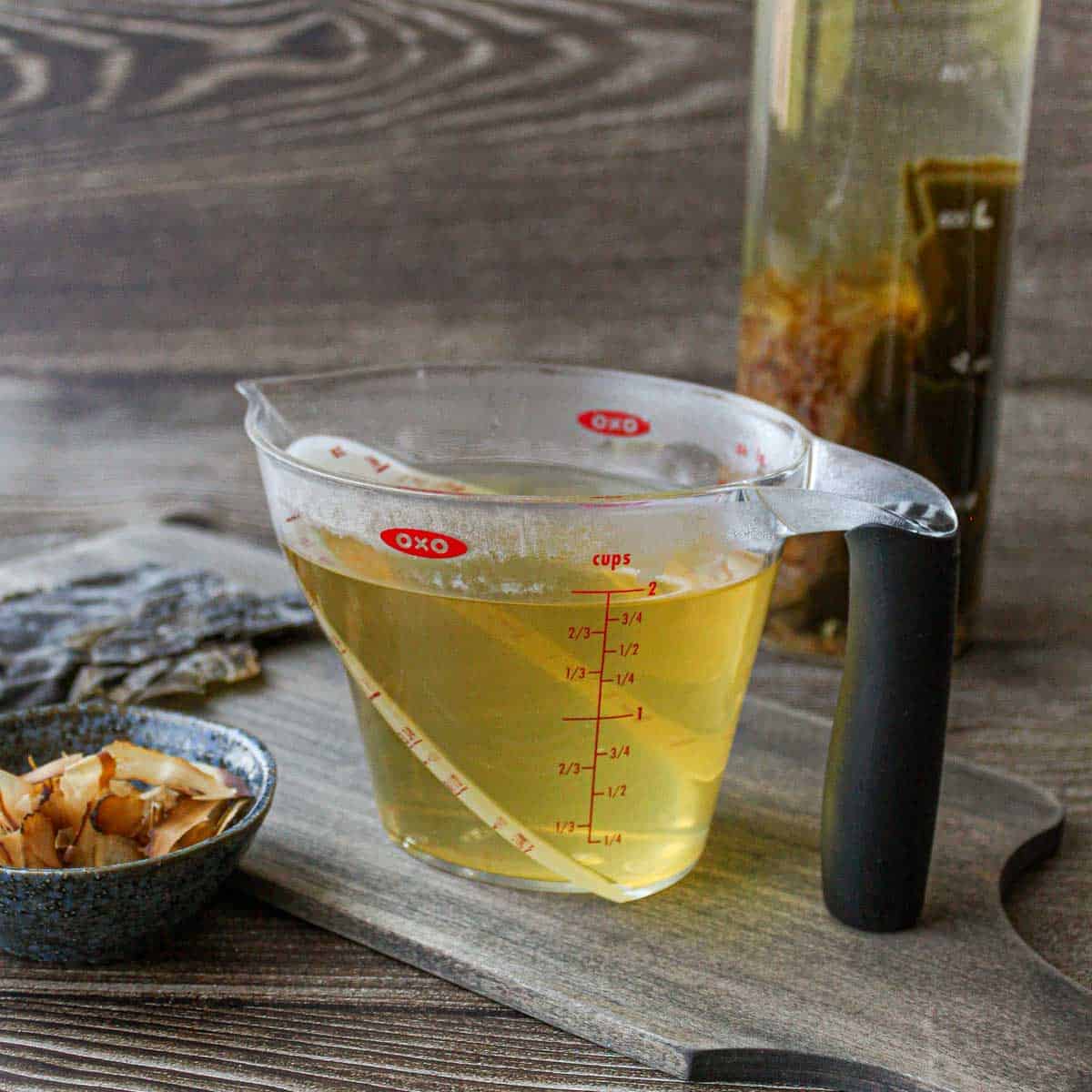Ingredients
Method
Prep the Kombu
- Lightly wipe the surface of 10 g kombu with a damp, squeezed-out paper towel to remove any dust. Avoid scrubbing kombu, the white powder on the surface is natural umami (don’t wash it off!).
Option 1: Cold Brew (Overnight Method)
- Add kombu and 20 g bonito flakes to a container with 4 cups filtered water.
- Cover and refrigerate for 8 to 12 hours.
- Strain through a fine mesh sieve or paper towel. Done!
Option 2: Cold Brew Kombu + Hot Steep (Hybrid)
- Add kombu and 4 cups filtered water to a container. Let it soak in the fridge for 8 to 12 hours.
- Set up a bowl with a colander lined with paper towel for straining later.
- Remove kombu and pour the liquid into a pot.
- Heat over medium until small bubbles begin to rise from the bottom (don’t boil).
- Turn off the heat. Sprinkle in the bonito flakes evenly and let steep for 1 minute (don’t stir!).
- Strain through a colander lined with paper towel. Don’t press or stir the flakes.
Option 3: Quick Steep (Stovetop Method)
- Add kombu and 4 cups filtered water to a pot. Let it soak for 30 minutes to 90 minutes.
- Set up a bowl with a colander lined with paper towel for straining later.
- Heat over medium-low for 20 to 30 minutes, or until small bubbles appear around the edges of the kombu. You should see some steam and smell the kelp. If the thickest part feels soft when you press it with your fingernail, it’s ready.
- Remove the kombu.
- Increase the heat to medium. Once you see small bubbles rising, turn off the heat.
- Add bonito flakes and let steep for 1 minute (don’t stir).
- Strain through a paper towel–lined colander. Don’t squeeze the flakes.
Niban Dashi (Second Brew, Optional)
- After straining the ichiban dashi, return the used kombu and bonito flakes to the pot.
- Add the same amount of water as the first brew (4 cups).
- Bring to a boil over medium heat, then reduce to low and simmer for about 10 minutes.
- Turn off the heat. Add about 5g (⅓ cup) of fresh bonito flakes and let it steep for 30 seconds.
- Strain through a colander lined with paper towel.
Notes
- Water: Soft water extracts more umami. Use filtered water (e.g. Brita) if you’re in a hard water area like the U.S.
- Kombu (Dried Kelp): Use thick, sheet-style kombu like WEL-PAC. Ma or Rishiri kombu is best, but hard to find outside Japan. If your kombu seems thin, use a little more. Don’t rinse the white powder, it’s natural umami.
- Katsuobushi (Bonito Flakes): Use thin-shaved (usu-kezuri) flakes like Kaneso Hanakatsuo. Avoid powdery topping-style flakes.
- Substitutions:
- Kombu → Dried shiitake, MSG, or vegetable dashi
- Katsuobushi → Dried anchovies (niboshi), shiitake
- In a rush? Use dashi powder or dashi packs
- Tips: To keep your dish flavorful, pair an amino acid source (like kombu) with a nucleic acid source (like bonito flakes). If you swap one out, add the missing umami component with other ingredients like tomatoes or mushrooms.
- Ingredient Ratio (to Water):
- 4% = Strong dashi for clear soups, chawanmushi
- 3% = Balanced flavor, great for cooking outside Japan (recommended)
- 2% = Light dashi for everyday home use
- Kombu to Katsuobushi Ratio:
- 1:2 = Best umami balance (glutamate:inosinate = 1:1)
- More kombu = Delicate flavor, for suimono
- More katsuobushi = Bold flavor, for miso soup/simmered dishes
- Reusing Ingredients:
Use spent kombu/katsuobushi for:- Furikake (pan-toast with soy sauce/mirin)
- Tsukudani (simmer with soy sauce, mirin, sake)
- Onigiri filling
- Dashi soy sauce (soak in soy sauce)
- Dashi ponzu (soak in ponzu)
- How to Use Awase Dashi: Great for miso soup, oden, dashimaki tamago, simmered dishes, chawanmushi, udon/soba soup, and Japanese curry.
- Storage Instructions:
- Dashi: Store in an airtight container for up to 3 days in the fridge or 2 weeks in the freezer (ice cubes work great for small portions).
- Used dashi ingredients (kombu and bonito flakes): Pat dry and store in an airtight container for up to 1 week in the fridge or 1 month in the freezer.
